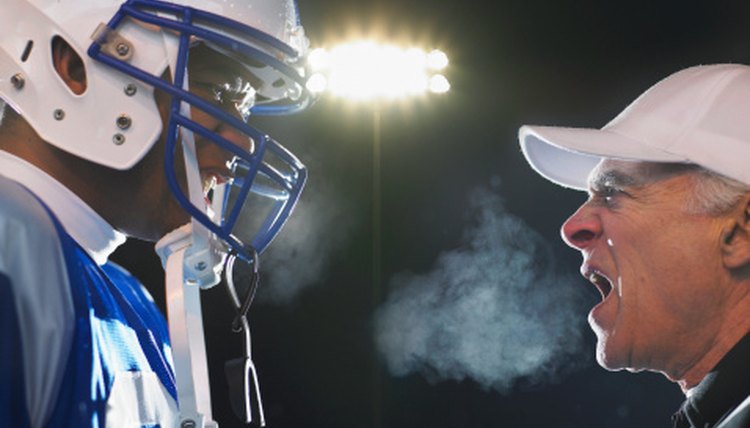Why Do Football Players Wear Bicep Bands?

Players on NFL and college football teams wear bicep bands. Bicep bands range in color and size and can be worn on one or both arms. The bands are made from old socks, swatches of stretchy material or athletic tape. Nike and the NFL also have their own lines of logo-endorsed bicep bands.
Function
Athletes wear these bands for a simple reason: vanity. Football and basketball players think the bands make their muscles look bigger. Bicep bands, like wristbands and headbands, also catch and absorb sweat.
Speculation
Bicep bands have no impact on the treatment of bicep pain, despite speculation to the contrary. Biceps tendinopathy, a disorder resulting from repetitive overuse of the bicep tendons, results in inflammation, pain and impaired function. Treatment of tendinopathy consists of reducing the inflammation, swelling and pain through physical therapy and nonsteroidal anti-inflammatory drugs. Despite speculated that bicep bands can help build muscle if worn during weight lifting, no medical proof backs up this claim.
Players
NFL players who wear these bands include New York Giants linebacker Danny Clark, New York Jets defensive end Dave Tollefson and Jets safety Kerry Rhodes. Clark wears his bands well above his elbows. “I’ve got all kinds of biceps and triceps busting out of there. It’s a good look,” he told the New York Times. Tollefson cuts his bands in half to make them skinnier. Rhodes claims that he’s been sporting the bicep bands since he was in high school.
Rules
The National Federation of State High School Associations bans the use of bicep bands. It sees the bands as frivolous and has banned them. High school players are allowed to wear wristbands that are to be no more than 3 inches toward the elbow.
References
- The New York Times: In Name of Fashion, Embracing a Trend
- Up to Date: Patient Information: Biceps Tendinitis or Tendinopathy
- Newsweek: Are Sports Accessories Based on Fads or Facts?
- Colado JC, Garcia-masso X, Pellicer M, Alakhdar Y, Benavent J, Cabeza-ruiz R. A comparison of elastic tubing and isotonic resistance exercises. Int J Sports Med. 2010;31(11):810-7. doi: 10.1055/s-0030-1262808
- Sangwan S, Green RA, Taylor NF. Characteristics of stabilizer muscles: a systematic review. Physiother Can. 2014;66(4):348–358. doi:10.3138/ptc.2013-51
- Martins WR, Safons MP, Bottaro M, et al. Effects of short term elastic resistance training on muscle mass and strength in untrained older adults: a randomized clinical trial. BMC Geriatr. 2015;15:99. Published 2015 Aug 12. doi:10.1186/s12877-015-0101-5
- Lee JW, Kim SB, Kim SW. Effects of elastic band exercises on physical ability and muscular topography of elderly females. J Phys Ther Sci. 2018;30(2):248–251. doi:10.1589/jpts.30.248
- Taylor JB, Ford KR, Nguyen AD, Shultz SJ. Biomechanical Comparison of Single- and Double-Leg Jump Landings in the Sagittal and Frontal Plane. Orthop J Sports Med. 2016;4(6):2325967116655158. Published 2016 Jun 28. doi:10.1177/2325967116655158
- Joy JM, Lowery RP, Oliveira de souza E, Wilson JM. Elastic Bands as a Component of Periodized Resistance Training. J Strength Cond Res. 2016;30(8):2100-6.
Writer Bio
Kimberly Day started writing professionally in 2009. She specializes in creative and technical writing and she authored the novel "Living and Dying." Day holds a Bachelor of Science in communication and business management from East Tennessee State University.
